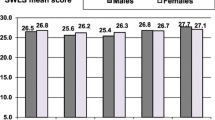Abstract
Two assumptions which characterize the measurements of quality life (QOL) studies, are questioned by the present report: First, the assumption that QOL is the same thing for all subjects, is usually related to health problems and can easily be measured across subjects. Second, when this assumption is given up by introducing subjective base-rates in an intra-subject (before-after) design, researchers still tend to assume that no response shifts occur on the QOL scales, e.g., that these scales maintain the same meaning and values for subjects over time and interventions. In our study we found that QOL had different subjective interpretations [1--4]. While for some certain issues in their family-life determined their quality of life, for others these were issues at their workplace or of their health conditions. Second, when QOL was tested against a subjective base-line (for each individual according to their choices of domains), about eleven percent of the hypertensives and normotensives showed a clear response shift of scale-calibration over the period of one year. When the scores of these subjects were excluded, the significance of certain previously reported results changed. For example, the significant difference between normotensives and hypertensives concerning the change in their subjective evaluation of QOL over the year and their initial depression became more significant, while similar changes in their evaluation of sexual impairment and control at their work-place became insignificant. These results suggest that response shifts have to be traced and quantified, before one can claim any results (or lack of results) in 'before-after' designs, concerning subjective meaningful issues like quality of life.
Similar content being viewed by others
References
Alloy, L. B. and L. Y. Abramson: 1979, 'Judgment of the contingency in depressed and nondepressed students: Sadder but wiser?', Journal of Experimental Psychology: General 108, pp. 441–485.
Amir, M. and D. Bar-On: 1996, 'Hypertension and quality of life: The disease, the treatment or a combination of both', Psychology and Health 11, pp. 685–695.
Amir, M. and D. Bar-On: 1996, 'Positive-negative evaluation (PNE) scale: A new dimension of the subjective domains of quality of life measures', Quality of life Research 5, pp. 73–80.
Armenakis, A. A. and A. G. Bedian: 1982, 'On the measurement and control of beta change: A replay to Terborg, Howard and Maxwell', Academy of Management Review 7: 296–299.
Bar-On, D.: 1986, 'Professional models versus patients' models in the rehabilitation after heart attack', Human Relations 39(10), pp. 917–932.
Bar-On, D. and M. Amir: 1993, 'Re-examining quality of life of hypertensives: A new, self-structured measure', American Journal of Hypertension, 6(3), pp. 62S–66S.
Deyo, R. E.: 1991, 'The Quality of life, research, and care (Editorial)', Annals of Internal Medicine 114, pp. 695–696.
Golembiewski, R. T., K. Billingsley and S. Yeager: 1976, 'Measuring change in human affairs: Types of change generated by O.D. designs', Journal of Behavioral Sciences 12, pp. 133–157.
Lazar, A.: 1996, 'Multi-dimensionally of the concept of change: Measurement and conceptualization', Unpublished MA thesis, Ben Gurion University of the Negev.
Nisbett, R. E. and T. D. Wilson: 1977, 'Telling more than we can know', Psychological Review 84, pp. 231–259.
O'boyle, C. A., H. McGee, A. Hickey, K. O'Mally and C. R. B. Joyce: 1992, 'Individual quality of life in patients undergoing hip replacement', Lancet 339, pp. 1088–1091.
Randolph, W. A. and D. F. Elloy: 1989, 'How can O.D. consultants and researches assess gamma changes: Comparison of two analytical procedures', Journal of Management 15, pp. 633–648.
Terborg, R. J., G. S. Howard and S. E. Maxwell: 1980, 'Evaluating planned organizational change: A method for assessing alpha, beta and gamma changes', Academy of Management Review 5(1), pp. 109–121.
Yaniv, N. and D. Bar-On: in press, 'A cumulativemeta-analysis of quality of life changes among male hypertensives in drugs-induced studies', Psychologia (in Hebrew).
Yodfat, Y., D. Bar-On, M. Amir and N. Cristal: 1996, 'Quality of life in normotensives compared to hypertensives men treated with isradepine or methyldopa monotherapy or in combination with captopril: The LOMIRMCT-IL study', Journal of Human Hypertension 10, pp. 117–122.
Author information
Authors and Affiliations
Rights and permissions
About this article
Cite this article
Bar-On, D., Lazar, A. & Amir, M. Quantitative assessment of response shift in QOL research. Social Indicators Research 49, 37–49 (2000). https://doi.org/10.1023/A:1006933612340
Issue Date:
DOI: https://doi.org/10.1023/A:1006933612340




